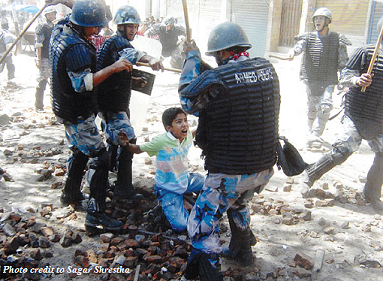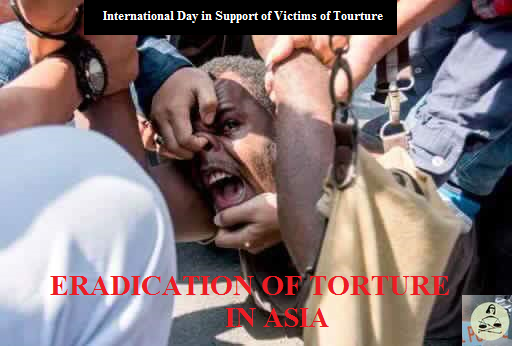A Statement by the Asian Human Rights Commission (AHRC) on the occasion of International Day in Support of Victims of Torture
 ‘“As a last resort,” wrote a Nepalese Inspector, “torture is practical and necessary.”’ This was reported 43 years ago in certain newspapers in the United States, in articles titled “Chilling views on torture tactics” and “Foreign Cops Favor Torture” . These articles detailed how students at the International Police Academy (a school then run by the State Department of the United States to train foreign police officers) had developed ‘some chilling views’ about torture tactics.
‘“As a last resort,” wrote a Nepalese Inspector, “torture is practical and necessary.”’ This was reported 43 years ago in certain newspapers in the United States, in articles titled “Chilling views on torture tactics” and “Foreign Cops Favor Torture” . These articles detailed how students at the International Police Academy (a school then run by the State Department of the United States to train foreign police officers) had developed ‘some chilling views’ about torture tactics.
Fast forward 43 years later, and the widespread use of torture by state forces in Nepal continues. While the Nepalese police officer of 1974 used the shield of “necessity” and “practicality” to justify torture, most 2017 police officers are using torture to further their own criminal intentions, such as obtaining a bribe or assisting politicians and elite, or simply because they were drunk and felt like beating someone up.
Corruption is not a new development, and has been widespread in Nepal for decades (perhaps centuries ). As a result, Nepal’s police have been weak in upholding criminal justice. What is new, is Nepal’s journey through a series of political earthquakes, leading to the reshuffling of the government and political players. From the world’s last Hindu Kingdom being ruled by an absolute monarchy,to limited democracy in the 1990s, to a decade-long violent Maoist insurgency revolting against widespread inequality and entrenched discrimination, which consequently resulted in the complete abolishment of the monarchy, paving the way for the advent of Federal Democratic Republic. Against this backdrop of political turmoil, Nepal is still struggling to emerge from the ashes.
The presence of the police force during this political turmoil has been a constanthowever, together with the torture of Nepalese people. The state of Nepal has inherited public institutions that have been in place for decades, including the police and the army. These institutions bring their ambivalent attitudes towards torture and impunity with them into so-called modern Nepal.
In May 2009, some eight years ago, the Supreme Court directed the government to formulate legislation criminalizing torture. This was nearly two decades after Nepal had ratified the Convention against Torture and Other Cruel, Inhuman or Degrading Treatment or Punishment (CAT), on 14 May 1991. Even though the 2015 Constitution noted that, “torture will be punishable”, torture is still not a criminal act in Nepal. Perpetrators continue to walk free and work in police stations with impunity.
Contrary to popular perception that torture is used to only extract confessions from guilty criminals (for ‘the innocent will never confess’), the AHRC’s regular monitoring in Nepal has shown that torture has largely been used as a tool to extract bribes, sanction the work of politicians and elite, social control on minority citizenry, and as a show of power. Even in instances where torture may have been used to obtain confessions, these are unreliable as they are not voluntary,and always result in the real criminals walking free.
While the government of Nepal has attempted to decentralize responsibility for torture to the individual police officer, in reality, it is solely responsible for creating situational forces that shape the characters of the individual police officers. The popular belief that no one will be prosecuted for the use of torture encourages individual officers to commit torture.
The availability of solutions to the current problem of widespread torture and impunity by the state forces – political will as demonstrated by the criminalization of torture , amending the Torture Compensation Act and the subsequent implementation of these laws – demonstrate that the failure of the State to adopt such measures render it directly responsible for torture.
Of course, the criminalization of torture and its strict implementation is not proposed as a panacea that will eradicate torture entirely. Indeed, torture is increasingly found in democracies, particularly where public monitoring of human rights is a core value. However, such a possibility should only result in the decision to step up monitoring efforts, rather than to admit defeat entirely.
The government of Nepal has a valuable window of opportunity in cleansing its image, revamping the government administration, and redesigning an efficient criminal justice system. This includes clamping down on torture by its security forces. In order to do this, the government must move beyond partisan interests and look at the bigger picture of what serves the country best. Torture undermines criminal and civil justice, without which there is no hope for peace and stability in the country.